Eldoret - 13th May - 15th May 2011
A late start and delays at the border meant a difficult drive into Eldoret, a busy and congested town, in the dark.
However, we spent a few days at the lovely Naiberi River Camp, with it's impressive camping facilities and bizarre cavernous restaurant, to recover from the trauma and plan our route around Kenya.
Cherangani Hills - 16th May - 17th May 2011
Next we headed north up into the Cherangani Hills. We had a wonderful day driving around the "Cherangani Highway" (obviously a dirt road) which looped in a circuit through the hills with our local guide, Moses. We stopped for walks up to a couple of peaks and a picnic lunch on the banks of a stream. This area produces many of Kenya's famous long distance runners and having staggered breathlessly up a couple of hills I can see how living here would get you into pretty good shape.
The views were spectacular all the way (the same cannot be said of the road unfortunately).
We shared our lovely campsite at Barnley's Guesthouse with a very engaging semi-tame De Brazzas monkey and shamelessly picked the brains of the owner, Dick Barnley, about our onward travel plans.
 | 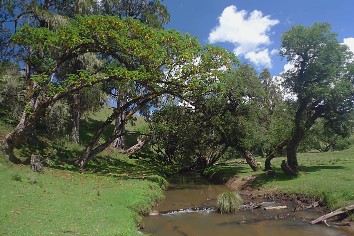 |
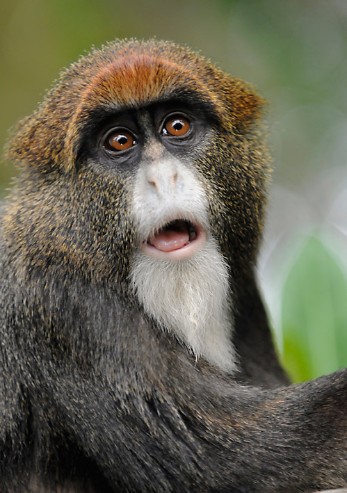 |  |
Saiwa Swamp National Park - 18th May - 19th May 2011
Staying in a swamp doesn't sound too promising but this was an idyllic spot. It is a tiny national park just a few square kilometres in size where you can walk along shady forest paths and watch the birds and the monkeys. We had it all to ourselves.
It's most famous residents are sitatunga - shy, semi-aquatic antelope with weird splayed hooves (look carefully below) to help them walk over reeds. We spent many peaceful hours sitting up in the observation hides watching the swamp inhabitants go about their business.
_D3S4324.jpg.opt355x250o0,0s355x250.jpg) | 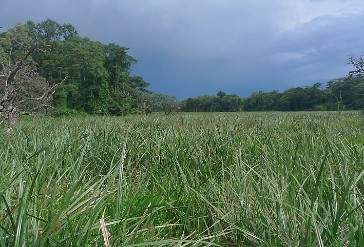 |
Lake Baringo - 20th May - 23rd May 2011
We drove back through Eldoret and down into the Kerio Valley where the road drops 1,000 metres into the bottom of the Rift Valley. Immediately the cool mountain air was replaced by heat and dust. Lake Baringo is the colour of milky tea and set against the dark grey skies (the long awaited rains have finally arrived) the scene is quite surreal.
The birdlife here is remarkable. It holds the record for the most species seen within a 24 hour period (342). We are not bird experts but we did have some close encounters with a curious (or perhaps just hungry) marabou stork. These beasts stand over a metre tall and are comically ugly - though having seen those beaks ripping carcasses apart in game parks you might not want to risk annoying one. Much cuter was the baby ostrich who took up residence in our dining area when the wind picked up each afternoon.
We used the rainy evenings as an excuse to upgrade to a lovely lakeside cottage with an ingenious semi-open air bedroom and a huge deck overlooking the lake.
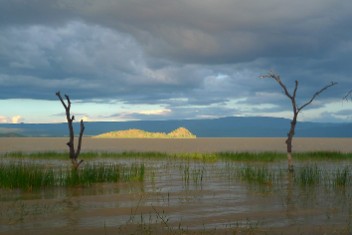 | 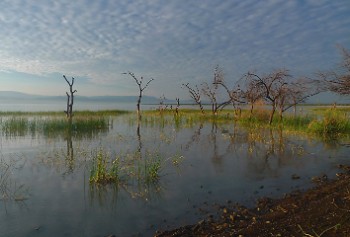 |
Lake Bogoria - 24th May - 25th May 2011
Just down the road from Lake Baringo is the next Great Rift Valley lake, Bogorio. They couldn't be more different. Whilst Baringo is atmospheric with sparse trees and dark water, Bogorio is deep blue and surrounded by lush green hills. Ironically whilst Baringo is fresh water Bogorio is alkaline and supports no fishlife. However, it does provide a feeding ground for thousands of flamingos which transform the lake shore into a pink carpet.
The other big draw at Bogoria are the hot springs which form bubbling pools of boiling water at the edge of the shore with powerful geysers of boiling water and steam shooting up from the lake. The flamingos seem immune to this and congregate where the water is hottest (the warmth encourages the growth of the algae they feed on).
All in all it makes for a pretty spectacular setting.
The campsite was also gorgeous. Set in a glade of enormous pre-historic fig trees and bordering the lake we watched the flamingos glide in in the evening to drink from the fresh water stream that went through our campsite (and functioned as our "bush shower").
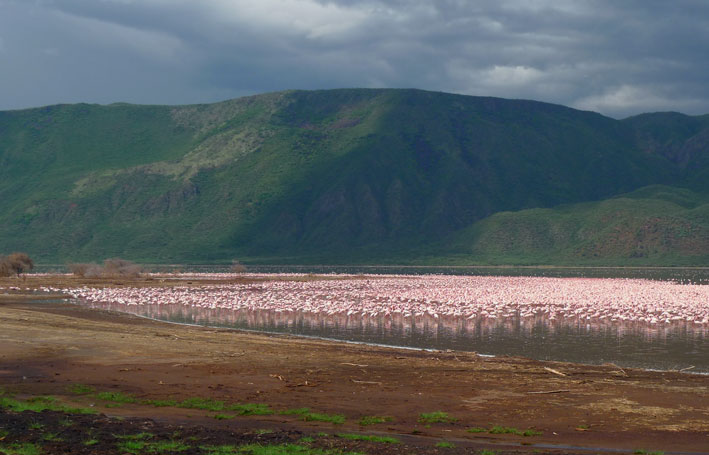 | 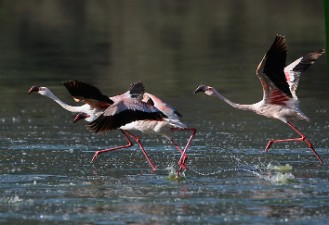 |
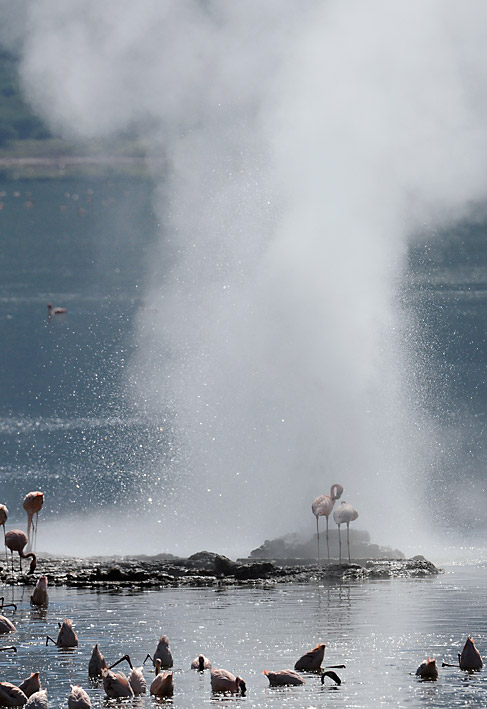 |  |
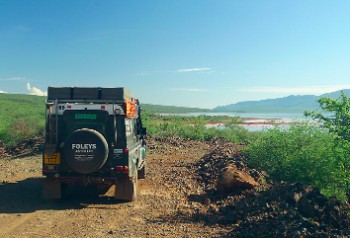 | 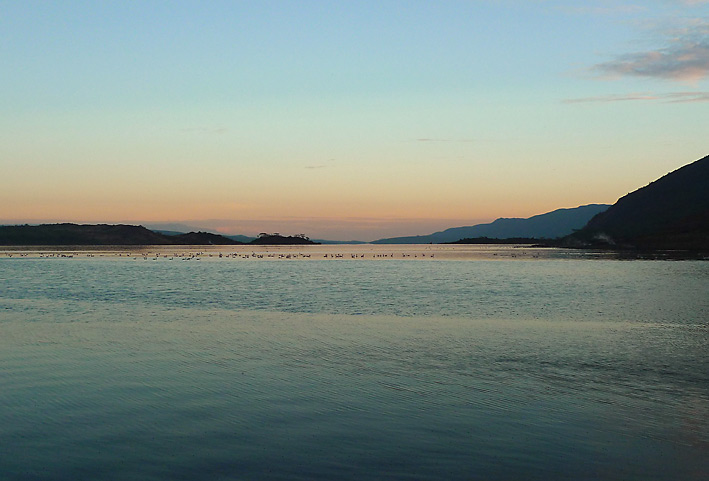 |
Lake Nakuru - 26th May - 27th May 2011
Lake Nakuru is one of Kenya's so-called "premium" parks (ie expensive). We could only afford 24 hours here. But it was beautiful. The lake is home to lots of birdlife, including plenty of flamingos but the stars of the show for us were the pelicans. These huge garroulous birds are endlessly entertaining, thrusting their heads underwater to scoop fish in perfect syncranisation, flapping the shallows with their wings whilst gabbling like geese to drive food to the surface and flying in rollercoaster formation like pterodactyls along the lake shore.
We stayed overnight at a remote campsite alongside a pretty waterfall. That night some rangers came to warn us there were lions just over the hill. Sure enough we heard them calling most of the night but they didn't put in an appearance. The next morning we set out to look for them and drove through a beautiful undulating landscape with the heavy dew sparkling in the sun and mist rising from the ground. No lions but the scenery more than made up for it.
Back at the gate we stopped for a bite of lunch and I was mugged ... by a baboon. He pushed past me trying to get into the back door of the car and hung on to the door frame for dear life whilst I hit him with the bag I happened to have in my hand. Finally he grabbed our bread (no sandwiches then) and made off with it. He sat a little way off and crammed slice after slice into his mouth. A few minutes later we went through the open window of a sedan car, sending the family still in it flying out of the opposite side of the car. It sounds funny but the males weigh 35 kg and have canines that are longer than a lion's so I guess he won't be up to his tricks much longer.
 | 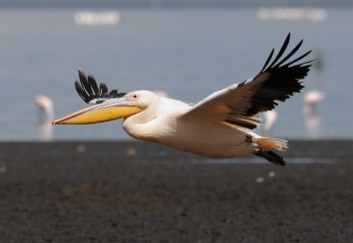 |
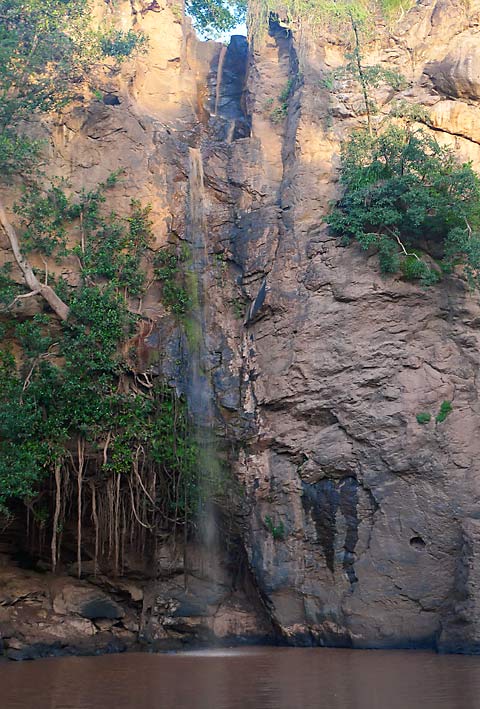 | 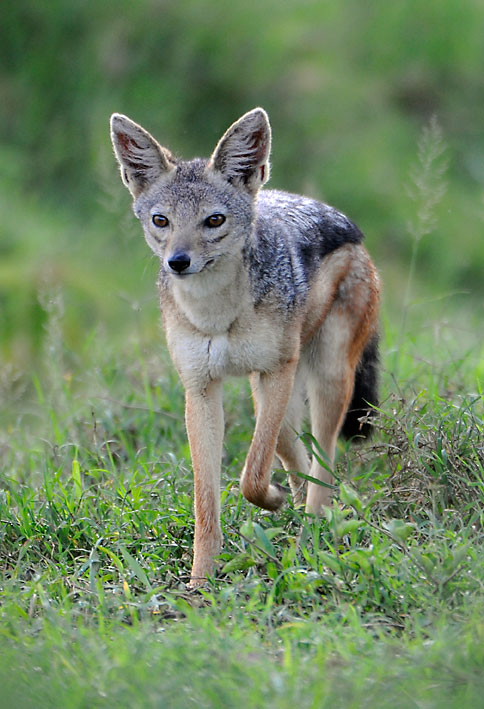 |
Lake Naivasha - 28th May - 31st May 2011
Another day another Rift Valley lake ....
Navaisha is where most of the roses that are grown in Kenya for export come from and as we drove in we could smell their scent on the breeze (these ones still smell of roses!)
We were now only a couple of hours out of Nairobi which had it's pros (the camp had a great bar and restaurant which did fabulous pizzas) and cons (it became party central at the weekend).
Seeking some solitude we headed off to Hell's Gate National Park for a couple of days where the only company we had in the campsite was a grumpy old bull buffalo. He snuck up on Jerry who was taking some early morning shots from the cliff top campsite. After a bit of a face-off the buffalo obviously decided Jerry was the scarier of the two and lumbered off.
We went on a guided walk along the bottom of the gorge that runs through the south of the park. Actually much of it was more of a rock climb than a walk and my arms and legs are still aching from the unaccustomed exercise. Scenes from Tomb Raider were filmed here but I don't think anyone watching me clamber over the rocks was reminded much of Angelina Jolie.
We spent our last morning there holed up in a raptor hide having secured hunks of meat from strategic spots in the vicinity but whilst we saw a huge eagle flying overhead a few times he wasn't tempted.
 | 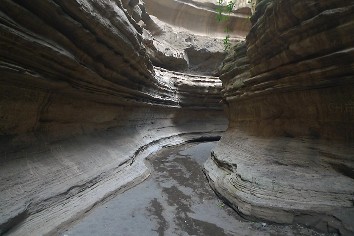 |
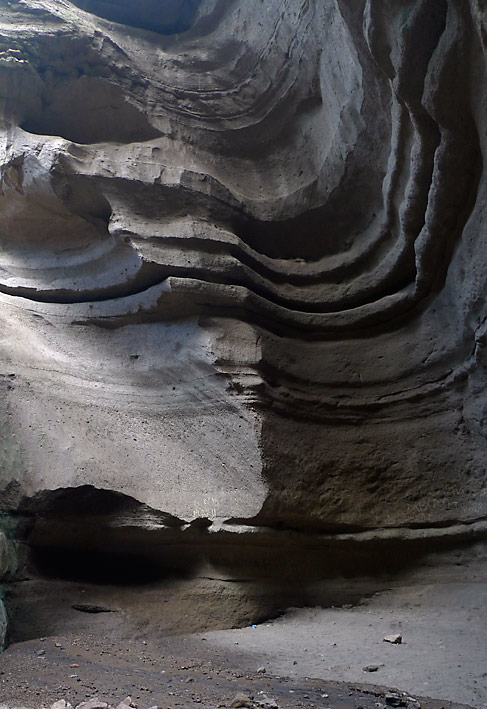 | 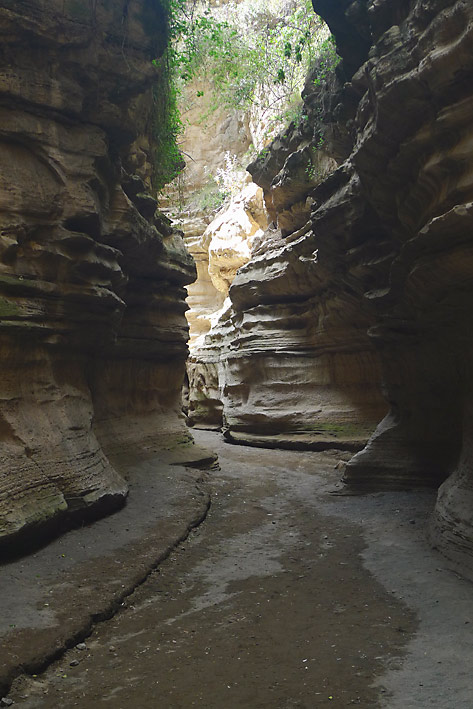 |
Nairobi - 1st June - 4th June 2011
The dreaded drive into Nairobi (traffic chaos capital of Africa, and perhaps the World) wasn't as bad as we had feared perhaps because it was a public holiday. We have the usual chores and errands to do here. Fixing bits and pieces on the car. Buying stuff we won't be able to get further north, organising visas and so on.
Masai Mara - 4th June - 12th June 2011
We breathed a sigh of relief as we left the city behind us but there was only a brief respite in stress levels. To get down into the Rift Valley floor we had to go over the escarpment. This is 9km of steep winding hairpins with sheer drops down into the valley below. Which wouldn't be too bad were it not for the fact that 90% of the traffic consists of huge heavily loaded trucks. It didn't help that at the first corner there was a crane positioned about to try and haul up a mangled car teetering on a slight ledge a couple of hundred metres below.
We eventually arrived, having taken a small diversion through a village of very tipsy locals when our GPS took us down a road that ended in a pile of rocks.
The scenery was just beautiful. Golden grass dotted with acacias.
We chose to stay in the Mara Triangle which though a little more expensive than the reserve itself overall allowed us to bush camp rather than leave the park every evening. The campsite we settled on was set on a small hill with stunning views and we had nightly visits from elephant and hyena (though we're still not sure what took off with our empty beer bottles...).
It was tempting just to follow the game viewing vehicles, who all have radios to pass on sightings instantly, but instead we tried to find our own things to see and whilst I'm sure this meant we saw far fewer lions, cheetah etc, we enjoyed it more without the throng of vehicles jostling for a view and the excited squawking coming from within. And we did manage the "Big 5" so we can't complain.
Highlights in the Triangle included:
-
Seeing the zebra pick their way across the river whilst enormous crocodiles lay in wait. Not all of them made it as seen in the picture below!
-
Witnessing a cheetah catch a Thompson's gazelle with incredible grace and confidence. It ran towards and through the antelope making you think, "Wow that's fast!" Then once it had chosen it's target, accelerated like a rocket, taking just seconds to bring the unfortunate gazelle down.
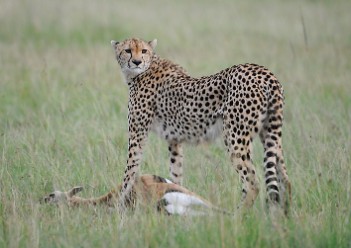 | 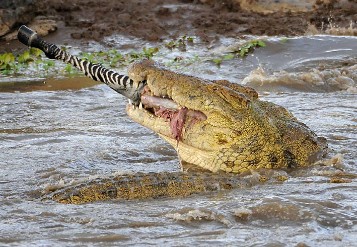 |
-
Spotting a leopard in a tree (or to be more accurate spotting three cars watching a leopard in a tree) and seeing it climb down (after two of them had lost patience and driven off!)
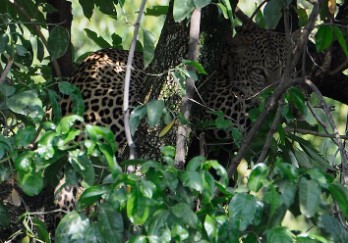 | 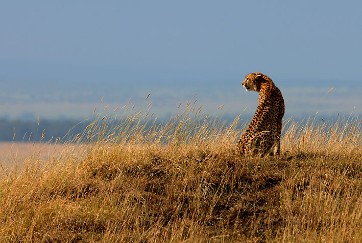 |
After a few days we ventured into the game reserve proper. We spent a memorable couple of days down at Sand River in the south of the reserve where we saw the first signs of the migration. It was hard to estimate numbers but I guess 10,000 plus zebra and wildebeest were there. It was nice to go to sleep to the sound of the wildebeests constant honking. And of course there were the obligatory lions doing their best to keep the population under control.
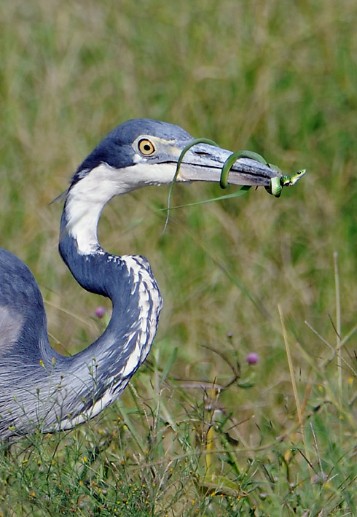 | 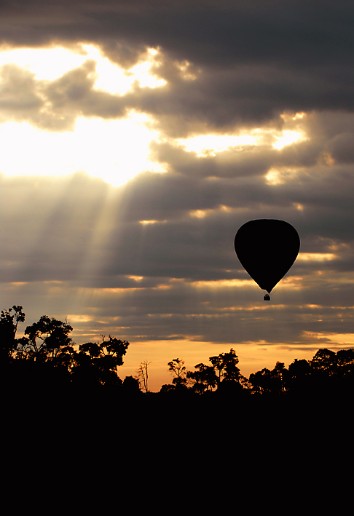 |
Unfortunately the balloon trip was beyond our means on this trip, but they make a beautiful sight drifting across the sky in the early morning.
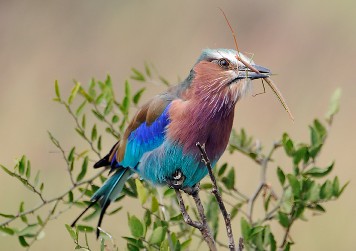 | 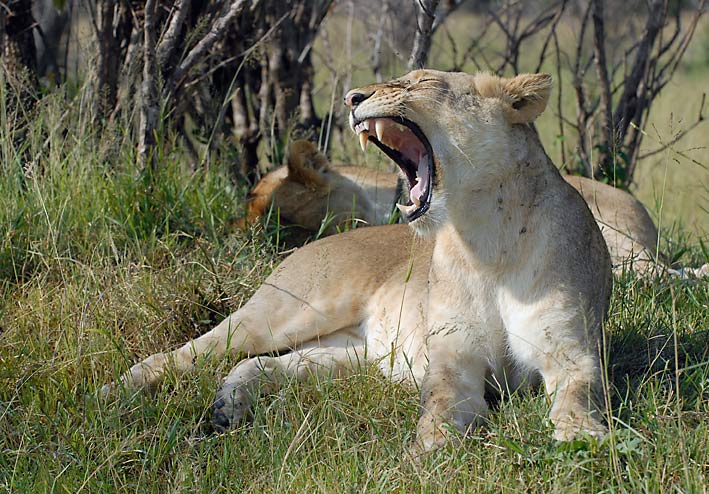 |
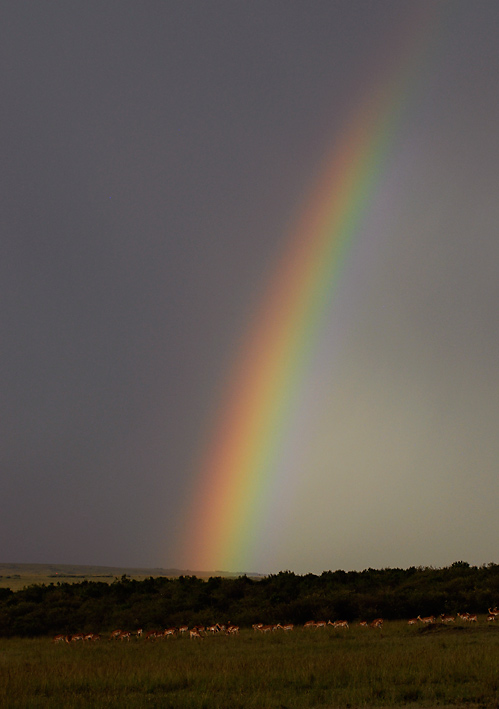 |  |
For more pictures of the Masai Mara click here.
Nairobi - 12th June - 19th June 2011
This was a week of fixing a few last things on the car before the rough roads that lead north, splurging on free wi-fi and swapping travelers tales and information with people traveling in the opposite direction. We based ourselves at Jungle Junction, a legendary campsite/workshop/refuge for overlanders in central Nairobi.
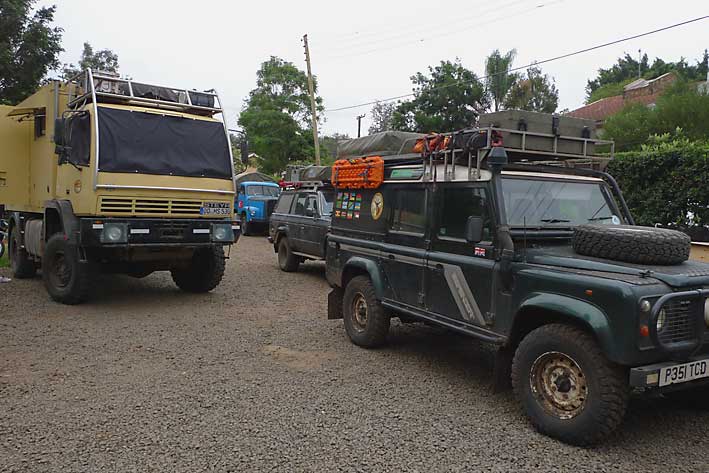 | 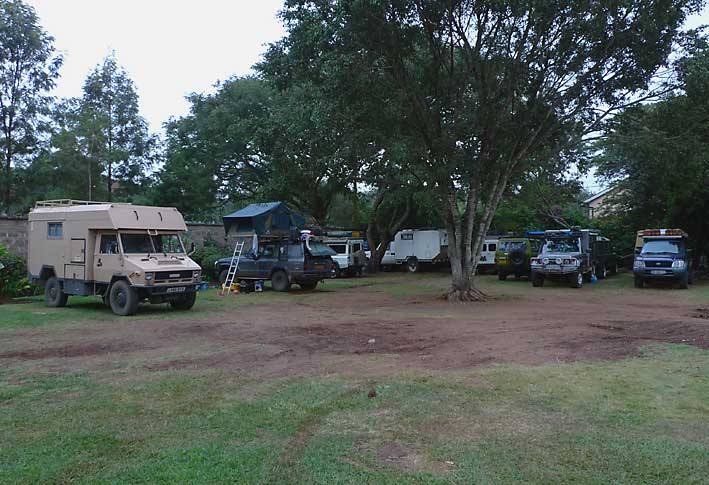 |
Timau - 20th June - 22nd June 2011
We drove out of Nairobi. Unfortunately the road we needed to take was undergoing some major work. Fly-overs were being taken down and diversions (obviously unsignposted) were the order of the day. Eventually though we were headed out of the city and towards Nanyuki.
We set up home in a lovely little log cabin on the slopes of Mount Kenya.
Lake Turkana - 22nd June - 26th June 2011
We had thought long and hard about our route out of Kenya. The 2 day trip along the "main" road to Moyale is notorious for being a real axle-breaker. It also passes through bandit country and we knew that some French travelers had been shot at and injured a couple of weeks before. On the other hand the route via Lake Turkana is also the stuff of travelers' legends; very remote with limited fuel and water and difficult route finding and road conditions. Our decision was made when we met up with another SA/English couple, Dave and Naomi, wanting to travel the Turkana route. We decided to travel in convoy.
We met at the Yare Camel Club in Maralal (this is the desert after all) and set off. After a few minutes we were on an incredibly rocky road climbing out of Maralal. The first 50 km took us 3 hours and we began to wonder what we had let ourselves in for. Before too long we met our first gun-toting locals but all seemed friendly and waved happily at us as we lurched past. We stopped to look out on amazing views of the valleys below and stopped for the night at a lovely little campsite in South Horr.
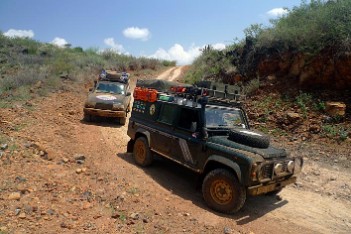 |  |
The next morning we faced a relatively short day (90km) to the lakeside village of Loiyangalangi but had heard tales of arduous driving across boulder fields and down a notoriously bad bit of road known as "the Staircase" to the lake shore. As was to prove the case with much of this journey, the reality didn't quite live up to the spin and the road was just fine.
The landscape here is starkly beautiful and almost other-worldly. The rocks are black lava and the contrast against the blue sky and blue-green waters of the lake is dramatic. A hot wind blew in across the desert and it was easy to see how this could be a very inhospitable place to live. The traditional houses in this area are dome-like huts made of branches and grass, often covered by plastic sheeting or hammered corrugated metal. They looked incredibly hot and we were grateful for our roof tents. Dave tried to go out and take some pictures of some of the more photogenic locals but had to give up after the attentions of the wannabe guides became too much to take.
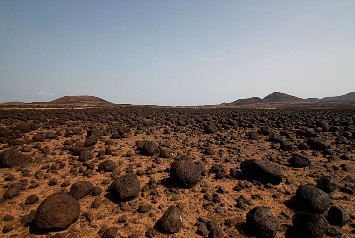 | 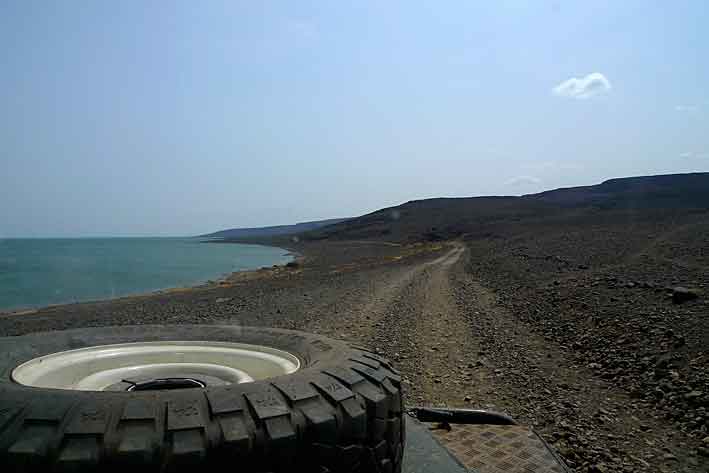 |
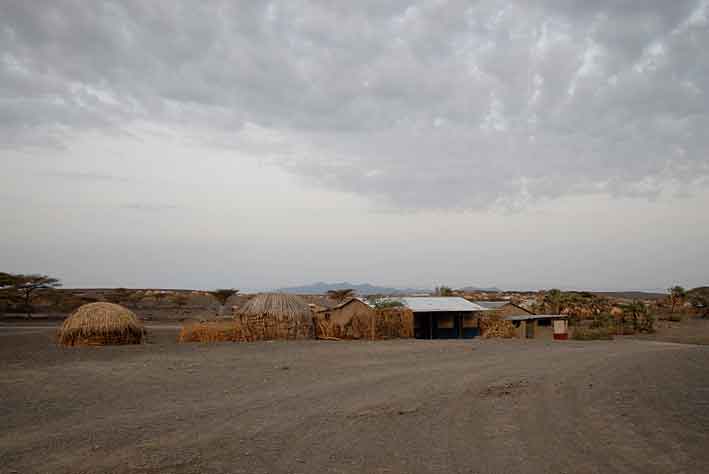 | 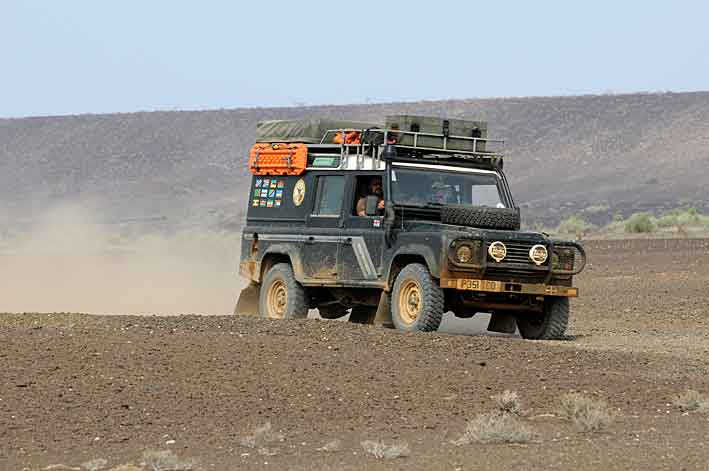 |
We were back on the road the next day and heading away from the lake and into the desert. The scenery became fairly repetitive and before too long we reached the entry gate to Sibiloy National Park. The ranger at the gate seemed to think that in return for issuing tickets to enter the park (and not pocketing the cash) he deserved some sort of payment. It proudly told me "Kenya is one of the most corrupt countries in the world" but we declined to contribute and went on our way. The sun was beating down and the wind was blowing and Dave struggled to rig up some shade with the awning and some tarpaulins.
The next day we found our way to Illeret, had our passport information recorded at the local police station, and drove to the Ethiopian border. There is not a road so much as multiple tracks through the sand but we were following the GPS tracks of some Dutch friends who had been that way a couple of weeks earlier so route finding wasn't too hard. We stopped in a village where there was a barrier (albeit lifted) but there was no where obvious to "check-in" so we drove on through knowing we would have to visit the Immigration office in Omorate about 35km away. We took a few wrong turns after this driving into a couple of villages providing the entertainment for the day with everyone coming out of their huts to take a look at the strange faranjes and the children shrieking and running alongside the cars. We were in Ethiopia.